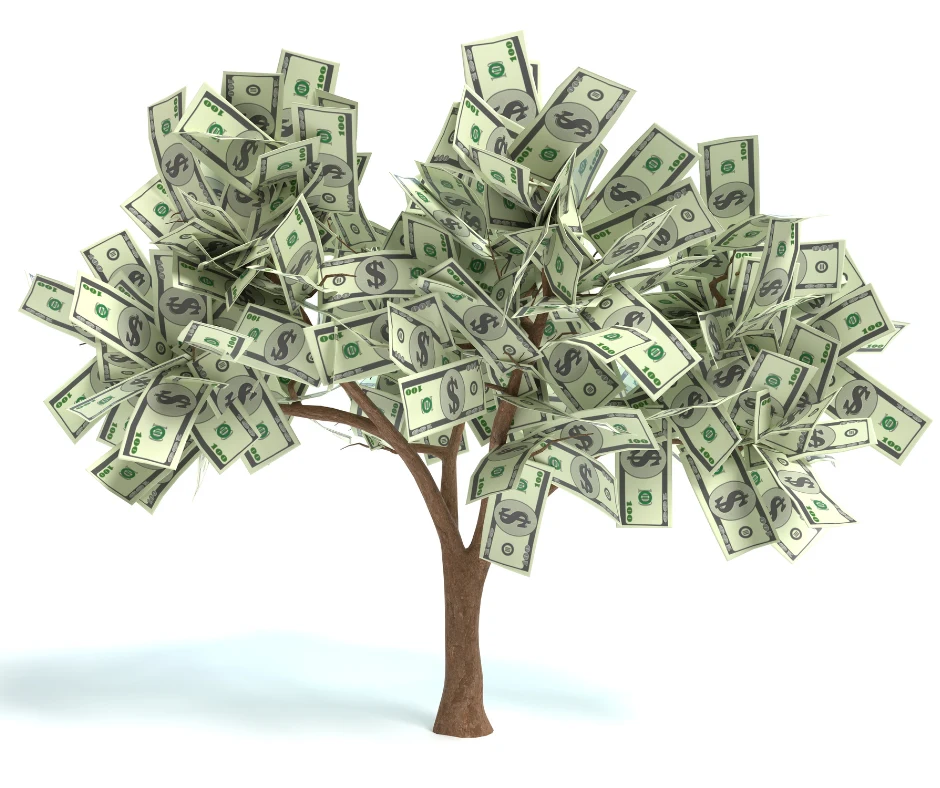Money is an essential part of modern life, but have you ever stopped to think about what it’s actually made of?
The answer might surprise you.
In most cases, the physical currency that we use every day is made from a combination of cotton and linen. This is true for both paper money and the fabric used to create the security threads and watermarks that help prevent counterfeiting.
However, the value of money isn’t actually in the physical materials it’s made of.
Instead, it’s a representation of the value that we place on goods and services. This is why paper money and digital currencies like Bitcoin can hold the same value as gold or other precious metals.
It’s all about perception and trust in the system. As such, the value of money is constantly changing based on a range of economic and political factors.
What is Money?

Definition of Money
Money is a medium of exchange that is widely accepted in transactions for goods and services. It can also be used to settle debts and taxes. In essence, money is a tool that enables people to trade with one another without the need for barter.
Functions of Money
The primary functions of money are as follows:
- Medium of exchange: Money is used to facilitate transactions between buyers and sellers. It is universally accepted as a means of payment for goods and services.
- Unit of account: Money is used as a standard unit of measurement for the value of goods and services. It enables people to compare the value of different goods and services.
- Store of value: Money can be saved and stored for future use. It retains its value over time and can be used to purchase goods and services in the future.
- Means of payment: Money is used to settle debts and obligations. It is accepted as payment for taxes, loans, and other financial obligations.
Types of Money
There are several types of money, including:
Sure! Here’s a table explaining the different types of money:
| Type of Money | Description |
|---|---|
| Commodity Money | Physical objects that have intrinsic value and can be used as a medium of exchange. Examples include gold, silver, precious stones, and other valuable commodities used in trade throughout history. |
| Representative Money | Money that represents a claim on a commodity, usually gold or silver, held by a financial institution. Examples include paper currency backed by gold or silver reserves, such as gold and silver certificates. |
| Fiat Money | Currency that has value because a government declares it to be legal tender. It does not have intrinsic value or backing by a physical commodity. The value is based on public trust and government regulation. Examples include most modern currencies like the US dollar, Euro, etc. |
| Digital Money | Money is represented and exchanged electronically. It exists purely in digital form and is typically stored and transacted through computer systems and digital wallets. Examples include cryptocurrencies like Bitcoin, Ethereum, and digital payment systems like PayPal, Venmo, etc. |
| Virtual Currency | Digital representation of value used within a specific virtual community or online game. Virtual currencies are typically used for in-game purchases or transactions within a specific online platform or virtual world. Examples include World of Warcraft gold, Second Life’s Linden dollars, and Fortnite’s V-Bucks. |
| Local Currency | A form of money used in a specific locality or community, often created to promote local economic activity and support local businesses. Examples include community currencies, regional currencies, and local exchange trading systems (LETS). |
| Cryptocurrency | A type of digital currency that uses cryptography for security and operates independently of a central bank. Cryptocurrencies are decentralized and typically based on blockchain technology. Examples include Bitcoin, Ethereum, Litecoin, and many others. |
What is Money Made of?
Money is a medium of exchange that is used for transactions.
It is a form of currency that is accepted in exchange for goods and services.
The value of money is determined by the government or the central bank of a country. In the United States, money is made of paper currency and coins. This section will explore the different components of money.
Currency
Currency is a type of money that is issued by a government. It is used as a medium of exchange for goods and services. In the United States, currency is issued by the Federal Reserve Bank. There are two types of currency: paper currency and coins.
Paper Currency
Paper currency is a type of currency that is made of paper. It is printed with various designs, vignettes, portraits, and numerals. The quality of the paper and the ink used in printing are important factors in determining the value of the currency. The U.S. Bureau of Engraving and Printing is responsible for printing paper currency.
Coins
Coins are a type of currency that is made of metal. The United States Mint is responsible for producing coins. Coins are made of various metals such as bronze, copper, and silver. The value of a coin is determined by its denomination and the metal it is made of.
Federal Reserve Notes
Federal Reserve Notes are a type of paper currency that is issued by the Federal Reserve Bank. They are the most commonly used form of currency in the United States. Federal Reserve Notes are printed with various security features to prevent counterfeiting. The printing process involves intaglio printing, offset printing, and metallic ink.
In conclusion, money is made of paper currency and coins. The value of money is determined by the government or the central bank of a country. The U.S. Bureau of Engraving and Printing and the United States Mint are responsible for producing currency and coins. Federal Reserve Notes are the most commonly used form of currency in the United States and are printed with various security features to prevent counterfeiting.
History of Money

Bartering and Trading
Before the introduction of currency, people used to trade goods and services with each other in a process called bartering. Bartering was a simple way of exchanging goods, but it had its limitations. The process was time-consuming, and it was difficult to determine the value of goods.
Introduction of Currency
The first currency was introduced in Lydia, a kingdom in present-day Turkey, around 600 BC. The currency was made of electrum, a naturally occurring alloy of gold and silver. The use of currency spread throughout Greece and eventually to other parts of the world.
Development of Paper Currency
Paper currency was first introduced in China during the Tang Dynasty (618-907 AD). The use of paper currency spread throughout the world, but it was not until the 17th century that paper money was used in Europe.
Gold Standard
The Gold Standard was a monetary system in which the value of a country’s currency was directly linked to gold. The Gold Standard was first introduced in the 19th century and was widely used until the early 20th century.
Electronic Money
Electronic money is a form of currency that exists only in digital form. It was first introduced in the 1990s and has become increasingly popular in recent years. Electronic money includes cryptocurrencies such as Bitcoin and Ethereum.
Throughout history, there have been many different types of money, including bartering, precious metals, paper currency, and electronic money. The development of money has played a crucial role in the growth of economies around the world.
How is Money Made?
Money is made by the Bureau of Engraving and Printing (BEP), which is a part of the United States Department of the Treasury. The BEP is responsible for designing and printing all paper currency in the United States.
The Bureau of Engraving and Printing
The BEP is located in Washington, D.C. and Fort Worth, Texas. The Washington, D.C. location is responsible for printing paper currency, while the Fort Worth location is responsible for printing postage stamps and other government documents. The BEP was established in 1862 and has been responsible for printing money ever since.
The Printing Process
The printing process used by the BEP is called intaglio printing. This process involves engraving the design onto a metal plate, which is then used to print the design onto paper. The BEP uses both offset printing and intaglio printing to produce the intricate designs and security features found on U.S. currency.
Security Features
U.S. currency has several security features to prevent counterfeiting. One of these features is a watermark, which is a faint image of the portrait on the bill. Another feature is color-shifting ink, which changes color when the bill is tilted. Serial numbers and plate printing are also used to prevent counterfeiting.
Quality Control
The BEP has a rigorous quality control process to ensure that each bill is printed correctly. Each bill is inspected by hand and by machine to ensure that it meets the BEP’s high standards. The BEP also tests each batch of ink and paper to ensure that it meets their specifications.
In conclusion, the BEP uses a combination of intaglio printing and offset printing to produce U.S. currency. The BEP also uses several security features and has a rigorous quality control process to prevent counterfeiting.
Final Thoughts
In conclusion, money is made of various materials depending on the denomination and the country of origin. The most common materials used for producing coins are copper, nickel, and zinc alloys, while paper bills are typically made of cotton and linen fibers. However, some countries use polymer materials for their banknotes, which are more durable and resistant to counterfeiting.
While the physical composition of money is important, its value ultimately depends on the trust and confidence that people place in it. Money serves as a medium of exchange, a unit of account, and a store of value, facilitating economic transactions and enabling trade and commerce.
As economies and technologies evolve, the nature and form of money may also change. Cryptocurrencies, such as Bitcoin and Ethereum, have emerged as digital alternatives to traditional money, using blockchain technology to create decentralized and secure payment systems. However, their adoption and regulation are still uncertain, and they face challenges in terms of scalability, stability, and usability.
Overall, money is a complex and multifaceted concept that plays a crucial role in modern societies. Understanding its origins, functions, and properties can help individuals and institutions make informed decisions about their financial activities and strategies.
